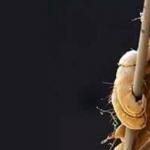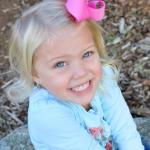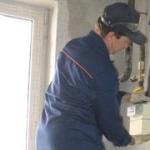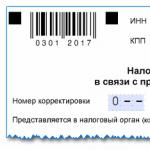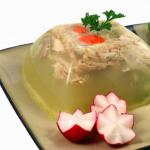Goals:
- Educational.
- Learn to distinguish between prefixes and prepositions.
- Strengthen the ability to distinguish and highlight prefixes and prepositions.
- Improve the ability to identify and distinguish prefixes and prepositions.
- Developmental.
- Replenish and activate vocabulary through the selection of adjectives, mastering educational terminology on the topic of the lesson.
- Develop the ability to compare based on independently identifying significant features for comparison.
- Correct and improve reading and writing skills through training exercises.
- Improve reading comprehension using deformed text.
- Educational.
- Cultivate interest in words through the use of entertaining material.
- Improve self-control skills based on comparison with a model.
- Foster a culture of communication through the ability to listen to each other.
Equipment. Cards, multimedia projector, computer, screen, notebooks.
PROGRESS OF THE CLASS
1. Organizational moment
1. Greet the guests. Wish each other success in class. So that everything works out for you when completing grammar tasks. In every lesson we learn something new. To gain knowledge today you need to complete the tasks prepared by the Queen of Grammar.
2. Determine whether the highlighted letters are prefixes and prepositions.
The words are written on the board:
In..went, on..the plane, from..the pier, set off..from..the roof, fell..fell, on..picked up, on..shore.
Teacher: If this is a prefix, cross out the space character that is not needed in this case. Read and name the prepositions.
Students: Perform orally, explain each word.
Teacher: Why are you having trouble?
Students: We don’t know how to distinguish a prefix from a preposition.
Teacher: What problem do we have to solve in class?
Students: We will distinguish between prefixes and prepositions.
Teacher: Why do we need to learn to distinguish between them?
Students: To correctly write words with prepositions and prefixes, to be able to correctly use prefixes and prepositions in speech, to write correctly.
2. Report the topic of the lesson(slide 1)
Teacher: Conclude what is the topic of today's lesson?
Students: Prefixes and prepositions.
Teacher: Right. Today in class we will learn to distinguish a preposition from a prefix, train attention and memory, but in an unusual way. We will go to the kingdom of Grammar.
3. Formation of the psychological basis of speech
Teacher: I will now give you the figures: one is a “cube”, and the other is a “pyramid”. I give you instructions and you carry out the action. Ready? Let's start:
– place the pyramid on the cube;
– hold the pyramid over the cube;
– place the pyramid in front of the cube;
– put the pyramid…. cube.
– Why couldn’t you complete the last task?
Students: Missing word.
Teacher: Guess what word I said (near, next to, left, right, at...)?
Students: Place the pyramid near the cube.
Teacher: Right.
4. Repetition of previously acquired knowledge
Teacher: What is a preposition?
Students: This word.
Teacher: Why do you need a pretext?
Students: To connect words in a sentence.
Teacher: How do you spell a preposition with other words?
Students: Apart. (Slide 2)
Teacher: What is a prefix?
Students: A prefix is a part of a word that comes before the root and serves to form new words.
Teacher: How do you spell a prefix with words?
Students: Together. (Slide 2)
Teacher: So, let's go to the kingdom of Grammar. (Slide 3) Read the tongue twister, identify prefixes and prepositions:
The road to the city is uphill,
Fences - mountains.
5. Training exercises to distinguish between prepositions and prefixes.
Teacher: The Queen of Grammar sent us a letter with assignments.
1. Working with the word
Teacher: Read the words. (Slide 4) Determine where the words are with prefixes and where with prepositions?
on the car, sketched, copied, postcards, entered, plane, ran, path.
Teacher: How can I do that?
Students: You can insert a feature word between a preposition and a word, but you cannot insert anything between a prefix and a root.
Teacher: Let's check: in the car, let's try to insert a sign word (on the red car).
Conclude what it is on– prefix or preposition?
Students: On is a preposition, because you can insert the word: on a red car, written separately.
Teacher: Next word: scribbled, let's try to insert a word.
Students: Nothing works out, so it’s a prefix, it’s written together.
(Further similarly with all words).
Teacher: Name the words with prefixes from this exercise.
Students: I sketched, sketched, entered, ran.
Teacher: Name words with prepositions.
Students: On a car, from a postcard, on a plane, along a path.
Teacher: The first group will remember and write down words with prefixes, and the second group with prepositions. I give you time to memorize, at my command we write it down in a notebook. Don't forget to highlight the prefixes and underline the prepositions. Time has passed...
- Swap notebooks and check whether you wrote down the words correctly.
– Well done, you all coped with the task of the Queen of Grammar.
– Let us repeat again, how to distinguish prefixes and prepositions?
2. Working with phrases
Teacher: Write the words with prefixes and prepositions correctly. (Slide 5)
ran across the roof, drew a mark in the sand, tore off trees
Teacher: Let's check how you completed this task. (Slide 6) Name the words with prefixes.
Students: He ran, drew it, tore it down.
Teacher: How were the prefixes recorded?
Students: Together.
Teacher: Name words with prepositions.
Students: On the roof, on the sand, from a tree.
Teacher: How did you write prepositions with words?
Students: Separately.
Teacher: What rule did you use when performing this exercise? Students: you can insert another word between a preposition and a word, but not between a prefix and a root.
3. Compose a sentence with one of the phrases (exercise 2) - orally.
Physical education minute(slide 7)
Game "Fly"
4 commands (up, down, right, left). Start of the game from the center.
| fly | ||
Preparatory stage: updating attention. Children see the playing field and the fly. The presenter shows the path of the fly. Chain command: up, right, down, down, left, up - where did the fly stop? (In the center).
Main stage: monitoring the development of attention. There is no playing field, i.e. the presenter does not show the path of the fly, but gives instructions: left, up, right, right, down, down. Where did the fly stop? (Bottom right square). The pace is quiet, but more instruction is offered.
Playing with eyes closed: we give arbitrary instructions to switch attention. At the end we ask: “Where did the fly stop?”
Can be repeated several times.
4. Working with a sentence (text)
Teacher: Read the sentences. (Slide 8)
There was a mountain in the yard.
(In) the hall there is a fragrant Christmas tree.
There are many children (on) the mountain all day.
(On) the branches are toys.
Children ran (to) the fluffy beauty.
Mitya (on) a sled (from) rolled (from) the mountains.
- How many stories can be made from these sentences?
Students: 2.
Teacher: What will the first story be about?
Students: About the slide.
Teacher: Read the sentences that relate to this story. Students: There was a mountain in the yard. There are many children (on) the mountain all day. Mitya (on) a sled (from) rolled (from) the mountains.
Teacher: How can you title the story?
Students: Slide.
Teacher: What is the second story about?
Students: About the Christmas tree.
Teacher: Read it.
Students:(In) the hall there is a fragrant Christmas tree. (On) the branches are toys. Children ran (to) the fluffy beauty...
Teacher: What should we call this story?
Students: Christmas tree.
Teacher: Make up stories from the sentences you have in the envelopes. Highlight the prefixes and underline the prepositions.
Mutual verification. (Slide 9)
There was a mountain in the yard. There are many children on the mountain all day. Mitya sledded down the mountain.
There is a fragrant Christmas tree in the hall. There are toys on the branches. To the fluffy beauty
5. Selection of prepositions and prefixes. Handouts on cards.
Teacher: Insert prefixes and prepositions that make sense. Indicate prefixes and prepositions.
In the morning we began...pulling the net. ...shore...dragged together...fish and sea crayfish. ...the sea is lazy...the cat Murka walked and...climbed...the water. With her paw... she felt... the bottom of a small fish. Murka...grabbed a fish with her claws and threw it...on the shore to the kittens.
5. Summing up
Teacher: What did you learn in class?
Let us remember once again what a prefix and a preposition are.
Well done! You have successfully completed the tasks of the Queen of Grammar.
Thank you for your work, see you in the next lesson. (Slide 10)
METHODOLOGICAL ASSOCIATION OF Speech Pathologist TEACHERS
Open speech therapy session
Differentiation of prefixes and prepositions.
4th grade
teacher speech therapist
Municipal educational institution secondary school No. 5 named after. O.V. Gudkova
Borodina O.N.
April, 2015
Relevance of using ICT tools : Creating conditions for the effectiveness of speech correction and HMF.
Target: develop the ability to distinguish between prepositions and prefixes, use them correctly in speech and write.
Tasks:
familiarization with the distinctive features of prefixes and prepositions;
developing skills in correct writing of prepositions and prefixes;
developing the ability to work individually and in small groups;
formation of students’ communication skills (involvement in conversation; ability to listen and hear each other; ability to formulate and ask a question).
Type of activity : Lesson on improving knowledge, skills and abilities.
Form of organization of classes: Group speech therapy session.
Type of ICT tools used in classes : Universal presentation.
Required hardware and software: computer class, multimedia computers, projector, interactive whiteboard
I. Preparatory stage
1. Mobilizing stage
Task: emotional mood.
Instructions are given.
- Guys, we have guests in class today. Greet them with a nod and a smile.
– Wish each other success in class (wishing game “Good luck to you!”).
Students greet guests with a smile and a nod. Take turns touching the fingers of the same name on your neighbor’s hands, starting with the thumbs, and say:
–
I wish (thumbs touch)
– success (index)
– large (medium)
- in everything (unnamed)
– and everywhere (with little fingers).
- good luck in your class! (touch with the entire palm of the hand).
2. Statement of the educational task.
Today you and I are joining the team of young researchers “Pochemuchka” and in order to become full-fledged members of our team, you need to complete tasks and pass the selection process. This will be your login password.
Determine whether the highlighted letters are prefixes or prepositions. If this is a prefix, then cross out the space sign that is not needed in this case and find opposite the numbers indicated in the “Prefix” column. If you have a preposition, find the numbers indicated in the “Preposition” column. Then in the picture, find the points that are near these numbers. Connect these points with straight lines. And see what happens. (Slide 1)
What did you get?(Letters. They represent sounds that are difficult for us to pronounce.)
Right. Be aware of these sounds throughout the lesson!
Why do you have difficulty spelling words with prepositions and prefixes?(We don’t know how to distinguish a preposition from a prefix).
Teacher: So, what educational task do we have to solve in this lesson?(We will learn to distinguish between prepositions and prefixes).
Teacher: Why do you need to be able to distinguish between them?(To correctly write words with prepositions and prefixes, to be able to correctly use prefixes and prepositions in speech, to correctly write a letter, application and other documents).
Teacher: Name the topic of today's lesson.(Distinguish between prepositions and prefixes). (Slide2)
And the goal of our lesson is to learn to distinguish between prefixes and prepositions, write them correctly and use them in speech.
Teacher: Today Professor Owl will help us in our research.(Slide 3). He welcomes you to the Young Explorers Club and wishes you good luck.
II. Formation of the psychological basis of speech.
1. Exercise to develop orientation in space:
I'll give you the pieces now. One - "cube" , and the other – “pyramid" .
I give you instructions and you carry out the action. Ready? Then let's begin:
Place the pyramid on the cube
Hold the pyramid over the cube
Place the pyramid behind the cube
Place a pyramid of cubes.
Why were you unable to complete the last task?(Word missing).
Guess what word I missed?(Near, next to, left, right, at...)
To perform an action and understand someone’s phrase, you need to remember about small words - prepositions, they serve to connect words in sentences, are very similar to prefixes, but are written separately with words.
III. Working on the topic:
(Slide4)
In order to understand everything, Professor Owl invites us to examine this line:
BEFORE THE FUN IS GOING FOR A WALK FOR THE CRICKET EXCEPT FOR POLYANKEPO
What do you see here?(words)
Name the words you found in these lines.(The teacher agrees with other words that the children will find in the line, but only cheerful, cricket, walks, clearing stand out .) (Click).
Read what's left.(To, before, from, for, except for, on, for, by ) (Click).
What are these words?(These are prepositions).
- What do you know about prepositions? (This is a part of speech, serves to connect words in a sentence, is written separately from the words)
From what you have highlighted in the frames, find only the prefixes.(From, on, for, by). (Cry)
What do you know about consoles?(part of a word, used to form new words, written together with the word).
- Let's continue our research.
Write a sentence using only these words.(Cry) . (Children try to make a sentence) Does not work? Why?(No word connection).
What is needed to connect words in a sentence?(a preposition is required in the sentence)
What preposition should I insert?(children call na or po, choose a preposition By )
Make a proposal now.(A cheerful cricket walks through the clearing). (Cry).
- Prove that this is an excuse.(Between the preposition “by” and the word “clearing” you can insert a word. For example, along a beautiful clearing)
Why are prepositions needed in a sentence?(to connect words in a sentence)
2. Updating knowledge.
(Slide 5)
Game “Find the prefix and the pretext.”
What do you see on the board? (Onon the board we see phrases)
What do you think you will do, what will the task be?(We will select prefixes and prepositions)
Assignment: Choose prepositions and prefixes and prove them. (Work on slide)
Sample (...)earth transition - transition (...)earth
(...)city trip – trip (..)city
(...) school garden - garden (...) school
What interesting things did you notice while completing this task? (These phrases contain the same prefixes and prepositions)
(Slide 6)
So, in the Russian language there are the same prefixes and prepositions.
If there are the same prepositions and prefixes, then how to distinguish them? Let's figure it out and compare.(Slide 7).
We have 2 groups. The first group tells everything about prepositions, and the second group talks about prefixes. For each correct answer you receive bonuses.
What is a prefix?
What is a preposition?
What are they used for?
How do you write with words?
How to distinguish?
What parts of speech are they used with? (Used with different parts of speech: noun, adjective, verb, etc. A preposition is not used with a verb)
Try to remember these rules, because they will be useful to you when completing tasks.
IV. Physical exercise. (Slide 8).
And now, after difficult research, you can rest a little.
Fragment of the dance “Dance Teacher”.
V. Consolidation of knowledge.
Game "Find an excuse."(Slide 9).
Game “Make up word combinations”.
Task: create a phrase from these words. One condition: the preposition and prefix in the phrase must be the same. Highlight the preposition and prefix. Summarize: In the word “wrote” there is a prefix “on” because -….
Read, middle.
Lez, window.
Rushed, food.
Wing, table.
How many phrases are there? (Four)
Read the second from the top, the third, the last, the fourth from the bottom. Remember their order.
VI. Exercise for the eyes. (Slide 10)
Now, let's do some eye exercises. Sit up straight and watch the helicopter without taking your eyes off.
VII. Work in notebooks.
(Slide 11)
Now we open our notebooks and write down the date and topic of the lesson.
1. Delayed memory task:
Remember the phrases we made up. Write the first and third phrases. Check it out.
2.Game “Clever guys and smart girls”
Remember the program “Smart Men and Smart Girls,” where high school students compete in knowledge, skills and intelligence. Imagine yourself as a participant in this program. (Slide 14)
Choose the path on which you will feel confident. Read the assignment carefully. Complete the task in your notebook:
Yellow track:
Father (on) wrote the address (on) the envelope.
The boat (moved away) from the shore.
Green path:
(across) the yard, (from) returned, (beyond) the river, (on) flew
The Red carpet:
Insert prefixes and prepositions that make sense.
The rider (...)tied the horse (...) of the tree and (..) jumped (..) the saddle.
Examination:(
Who chose the green path?
Yellow? Red?
Compare your work with the sample. (On the slide)(Cry)
Correct errors if any.
Make sentences based on this picture using various prepositions. And one more condition: use adjectives in each sentence. Write down one of them. Peer review.
Work in groups.
Game "The offer fell apart."
We divide the children into 2 teams and distribute 2 envelopes with cut-out sentences.
What do you think we will do now (Make sentences)
Right. You will have to assemble a sentence from the words in the envelope. Please do not mix the words with words from another envelope. Collect one first, and then move on to the other. The team that completes the task faster and correctly will receive a prize.
Then we check the proposals and write down the 1 most liked proposal of the winning team (with pronunciation). Slide.
VIII. Result:
Now let's summarize our lesson.
What was the task?(Learn to distinguish and correctly write prefixes and prepositions)
What discoveries did you make for yourself during the lesson? (There are identical prefixes and prepositions. Prefixes are written together, and prepositions are written separately)
How to distinguish between a preposition and a prefix?
Which task gave you the most difficulty?
Our lesson has come to an end and in conclusion I want to read you a quatrain:
Prefixes to words are always added together and written together.
Prepositions from the words “are removed” - there is no trace of them in the words.
Exit password.
And the computer will draw the conclusions for you. We will take a test and find out how you have mastered the material. The computer will evaluate your work.
Our lesson is over.
Thank you very much for your work.
List of used literature:
Efimenkova Lyudmila Nikolaevna.
Correction of oral and written speech of primary school students: A manual for speech therapists / L.N. Efimenkova. - M.: VLADOS, 2001. - 336 p. : ill. - (Correctional pedagogy).
Lalaeva, Raisa Ivanovna.
Reading disorders and ways of their correction in primary schoolchildren: Proc. allowance / R.I. Lalaeva. - St. Petersburg. : UNION, 1998. - 221 p.
Yurova E.V.
Correction of written speech: Speech therapy: Manual for elementary school. / E.V. Yurova. - M.: Aquarium, 1998. - 208 p. : ill.
Yastrebova A.V.
To the teacher about children with speech impediments: [For teaching. beginning class] / A.V. Yastrebova, L.F. Spirova, T.P. Bessonova. - M.: ARKTI, 1996. - 159 p. : 8 l. appl. - (B-a practicing speech therapist).
STATE BUDGET EDUCATIONAL INSTITUTION
SPECIAL (CORRECTIONAL) BOARDING SCHOOL OF TYPE VII No. 73
Open speech therapy session on the topic:
"Differentiation of prepositions and prefixes."
(group lesson for children of primary school age,
having dysgraphic errors against the background of OHP)
Speech therapist teacher: Yuliya Ivanovna Erokhova
MOSCOW
2012
Speech therapy topic : prepositions.
Grammar topic : preposition as part of speech.
Lexical topic : toys.
Target : updating knowledge about preposition as a part of speech.
Tasks :
Educational :
Clarify children's knowledge about preposition as an independent word;
Improve the skill of composing a sentence based on a picture and linguistic analysis of a sentence;
Develop techniques of comparison, generalization, classification.
Correctional and developmental :
Update your knowledge about writing prepositions separately with other words;
Develop the skill of writing prepositions separately with other words;
To develop the skill of differentiating identical roots, homonym roots and roots that have graphic and acoustic similarities;
Correct and develop visual gnosis;
Correct and develop coherent oral speech through replenishment and activation of the vocabulary, and the formation of a full-fledged speech utterance;
Develop visual and auditory attention;
Correct and develop personal qualities, emotional-volitional sphere (skills of self-control, perseverance).
Educational :
Develop the skill of independence in work;
Develop the ability to work in a team;
Cultivate a caring attitude towards benefits and your belongings.
Health-saving :
Plan the volume of material taking into account the increased fatigue of children;
Ensure students are seated correctly;
Carry out work to prevent visual impairment;
Alternate static and dynamic tasks;
Contribute to the creation of a favorable psychological climate.
Equipment : magnetic board, story pictures, cards for individual work.
Technical training aids : multimedia projector, computer.
Multimedia support : presentation for the lesson.
Progress of the lesson.
Stagesclasses
Types of work on
stage
Activity
teacher
Activity
students
What tasks were solved during the tasks?
I. Organizational moment.
Establishing contact between teacher and students.
Checking readiness for class.
1.D/i “Look and answer”
2. D/i “Do this”
Greetings.
The speech therapist shows a picture of a ball in various spatial positions relative to pieces of furniture (table, closet, sofa).
The speech therapist says the instructions:
-put the pen on the notebook
-put the pen in the notebook
- put your pen behind your notebook
- put a pen under the notebook
-put down your pen and notebook.
What task were you unable to complete and why?
Students stand at their desks and greet guests.
Check readiness for class.
Students answer where the ball is (under the table, on the sofa, behind the closet...)
Students complete speech therapist tasks.
Answer questions.
(The last task was unclear).
Prepare students to work productively throughout the lesson.
Bring to the topic of the lesson.
II. Main part.
1. Semantic meaning of prepositions.
2. Working with text.
3. Complementing phrases with prepositions.
4. Dynamic pause.
5. Making a proposal based on the picture.
Guys, when I “forgot” to name the required preposition, you couldn’t understand where you should have put the pen. What words helped you complete other tasks correctly? (behind, on, under, in, before... )
What are these words called? What do prepositions show in a sentence?
The speech therapist shows the slide:
And then you rolled
And he didn’t turn back.
Rolled into the garden
Got to the gate
rolled under the gate,
I reached the turn...
What work is this excerpt from, and who is the author?
What happened to the ball then?
What words helped us find out which route the ball was rolling?
What part of speech do these words belong to?
How are prepositions written next to other words?
The speech therapist shows the slide:
Ran...a corner, ran into...a school, stepped on...a stick, cut off...a piece, took off...ropes, ran...on the road, bounced off...the door, drew...on a piece of paper.
Speech therapist turns on music
and shows movements.
On the board there is a plot picture depicting a doll sitting on a table
What is shown in the picture?
What is she doing?
Where is the doll sitting?
Make a proposal.
How many words are there in this sentence?
Which word shows where exactly the doll is?
How are prepositions written in sentences?
Students answer questions.
(Prepositions).
(Prepositions show where an object is or the direction of its movement).
Students read a poem.
Answer questions.
(in, up, under, until)
(these are prepositions)
(separately these are independent words)
Children read phrases and say what is missing from them. Write down phrases in a notebook, inserting prepositions.
Children repeat the movements of the teacher to the music.
Children look at the picture and answer questions.
(doll)
(is sitting)
(on the table)
The doll is sitting on the table.
(four)
(on the)
(separately with other words)
Children write down the sentence in a notebook.
Develop and correct auditory-verbal memory of students.
Develop attention, memory, spelling vigilance.
Update your knowledge about writing prepositions separately with other words. Develop logical thinking.
Develop fine and gross motor skills.
Develop coherent speech.
Develop the skill of writing prepositions separately with other words.
IV. Summary of the lesson.
Assessment of students' activities in class.
The teacher invites the children to remember what they did in class.
Children answer what they remember and especially liked.
Summarize the topic of the lesson. Develop memory.
State budgetary special (correctional) educational institution of the city of Sevastopol for students,
those in need of long-term treatment
“Comprehensive boarding school No. 6 VII type named after. E.I. Petrova"
Speech therapy session for correction of written speech
for 3rd grade school studentsVIIkind.
teacher-speech therapist Medova E.V.
Topic: Differentiation of prepositions and prefixes.
Goal: Improving the skill of spelling words with prefixes and prepositions.
Objectives: Educational: consolidate children's knowledge about parts of speech. Improve the skill of spelling words with prefixes and prepositions. Activating the vocabulary through the ability to form words using prefixes. Expansion of the semantic field of words. Formation of coherent speech.
Corrective: Develop auditory attention and memory. Improve fine and gross motor skills. Development of various thinking operations. Educational: Develop cooperation skills. Interaction, independence, initiative, positive attitude towards participation in the lesson. Development of self-control actions. Forming a sense of self-confidence.
Equipment: Blackboard, chalk, individual cards according to the number of students. presentation for the lesson.
During the classes
I .Organizing time
1. Breathing exercises. “Dandelion” Inhale through your nose. Hold your breath for a second and exhale forcefully: f-f-f... Blow forcefully on an imaginary dandelion so that the light fluffy umbrellas fly away in different directions. The exercise is performed several times.
2.Updating students' basic knowledge.
D/I “Name familiar prepositions and prefixes”
D/I “Answer the question in a complete sentence.”
What is a preposition? A preposition is a word that, like other words, is written separately from other words.
What is a prefix? ConsoleThis is a part of a word that is written together with the rest of the word and serves to form new words.
How not to confuse prepositions and prefixes?
Pretext- this is an assistant to the word denoting an object, so it can only appear before the name of the objectin the window) , or before the name of the item attribute(in an open window ) .
There are never prepositions before the names of the actions of objects:left, came,
ran in...
Can you guess what the topic of the lesson will be?
II. Main part
3. Clarification of the topic of the speech therapist session.
Today we will consolidate our knowledge and skills in spelling words with prefixes and prepositions.
And our friend the HEDGEHOG will help us with this. (Toy or picture)
Preparing your hands for writing
Development of fine motor skills of the fingers. Performing exercises with massage balls.
4.Record the number and topic.
5. Exercises in spelling words with prefixes and prepositions.
Forming verbs using prefixes.
D/I “Who is more” - select as many words of the same root with different prefixes as possible.
Fly: fly away, arrive, etc….
Climb: climb, climb over, etc...
Write it down in your notebook. Select prefix, root.
Exercise to train the visual apparatus. "Catch the Bunny"
The speech therapist uses a flashlight or mirror to launch a “sunny bunny” for a walk. Students, having caught the “bunny,” follow it with their gaze without turning their heads.
7. A visual representation of the relationship between prepositions and prefixes.
Students are invited to draw their own illustration of a sentence containing prepositions and prefixes.
A fly flew into the window.
The cat got off the sofa.
A cat runs away from a dog, etc.
8.Work on individual cards.
D/I “Lay out in two columns.”
Left - words with prefixes.
Right - words with prepositions. Highlight the preposition and prefix.
(under) chop
(from the city
(c)class
(give
(at) home
(from) measure
9. Exercise to train the visual apparatus. Drawing with the eyes of imaginary objects (flower, sun, cloud, etc...)
10. Making up phrases.
Make up pairs of words. In each pair, use the same prepositions and prefixes -
ON, FOR, FROM, BY, TO, IN, UNDER.
Sample: Swim, river - swam along the river.
There were mushrooms;
Drive, garage;
write,sheet;
chop, root;
Throw, stove;
ran, corner;
bite, bread;
Explain the spelling.
Write it down in your notebook .Highlight the prefix and preposition.
11.DYNAMIC PAUSE
This is the right hand
This is the left hand.
On the right is a noisy oak forest.
On the left is a fast river.
We turned around and here we are
Everything has become the other way around.
On the left is a noisy oak forest.
On the right is a fast river.
Has she really become right?
Our left hand?
12.Graphic dictation.
Write down sentences graphically, drawing instead of a prepositionV, and instead of the prefix
The path went down the mountain.
The flowers were cut at the root. etc…
13.Work at the text level.
Help the hedgehog write down the poem correctly.
Read the poem.
Vocabulary work. Clarification of the meaning of words:
Barge, lorry.
Drifts of snow blizzard ( broke, stranded )
And at the gate like a barge ( stranded, broke )
A lorry is worth it.
Well ( by the nose, skid ).
I went out the gate and it was freezing
How it will crackle and grab me ( skid, by the nose ).
Choose the words that suit their meaning and write down a comic poem. -Explain the spelling of the words.
III. Summary of the lesson.
Reflection of activity.
Repeat those statements that you think are correct?
Is a preposition a word?
Is a prefix part of a word?
Is a preposition used to connect words in a phrase and in a sentence?
Is the prefix written separately?
Is the prefix used to form new words?
Is the preposition written separately?
There are never prepositions before the names of the actions of objects?
, teacher-speech therapist, emergency situation (K) primary school - kindergarten No. 3 “Nadezhda” of the Ministry of Education and Youth Policy of the Chuvash Republic.
Educational.
- Strengthen knowledge, skills and abilities about prefixes and prepositions.
- Improve the ability to isolate a prefix from a word, and a preposition from a sentence.
Developmental.
- Replenish and activate vocabulary through the selection of adjectives, mastering educational terminology on the topic of the lesson.
- Develop the ability to compare based on independently identifying significant features for comparison.
- Correct and improve reading and writing skills through training exercises.
- Improve reading comprehension using deformed text.
Educational.
- Cultivate interest in words through the use of entertaining material.
- Improve self-control skills based on comparison with a model.
- Foster a culture of communication through the ability to listen to each other.
Progress of the lesson:
1. Organizational moment.
(Students have cards on their desks with words written on them)
Teacher: Read and name the prepositions.
Students: through the forest - the preposition through, with my brother - the preposition with, at the school - the preposition y, in front of the window - the preposition before, from the box - from, in the car - in, behind my brother - for, watering - there is no preposition in this word.
Teacher: No excuse?! What then is in it?
Students: console
Teacher: Name the prefix.
Students: by.
2. Report the topic of the lesson. (slide 1)
Teacher: Conclude what is the topic of today's lesson?
Students: prefixes and prepositions.
Teacher: That's right. Today in class we will learn to distinguish a preposition from a prefix, train attention and memory, but in an unusual way. We will go to the kingdom of Grammar.
Teacher: Why do you need to be able to distinguish between prepositions and prefixes?
Students: to write correctly and without errors.
3. Repetition of previously acquired knowledge.
Teacher: What is a preposition?
Students: this is the word.
Teacher: What is a pretext for?
Students: to connect words in a sentence.
Teacher: How do you spell a preposition with other words?
Students: separately. (slide 2.1)
Teacher: What is a prefix?
Students: a prefix is a part of a word that comes before the root and serves to form new words.
Teacher: How do you spell a prefix with words?
Students: together. (slide 2.2)
Teacher: So, let's go to the kingdom of Grammar (slide 3)
4. Training exercises to distinguish between prepositions and prefixes.
Teacher: The Queen of Grammar sent us letter with assignments.

1. Working with the word.
Teacher: Read the words. (slide 4)
Determine which words are with prefixes and which are with prepositions?
(behind) the mountain, (behind) run, (from) return, (from) roofs, (on) an envelope, (on) cut, (in) flew, (in) house
Teacher: How can this be done?
Students: you can insert a feature word between a preposition and a word, but nothing can be inserted between a prefix and a root.
Teacher: Let's check: (behind) the mountain, let's try to insert a sign word ( behind big mountain).
Conclude what is it - a prefix or a preposition?
Students: behind is a preposition, because you can insert the word: behind the big mountain, written separately.
Teacher: Next word: (to) run, let's try to insert a word.
Students: nothing works out, so for is a prefix, written together.
Teacher: Name the words with prefixes from this exercise.
Students: run, turn, cut, fly.
Students: over the mountain, from the roof, on an envelope, into the house.
Teacher: The first class will memorize and write down words with prefixes, and the second class will write down words with prepositions. I give you time to memorize, at my command we write it down in a notebook. Don't forget to highlight the prefixes and underline the prepositions. Time has passed...
Swap notebooks and check if you wrote down the words correctly.
Well done, you all completed the task of the Queen of Grammar.
Let us repeat again, how to distinguish prefixes and prepositions?
2. Logical thinking exercise.
Teacher: How are the figures on the right different from the figures on the left? (slide 5)
3. Working with phrases.
Teacher: Open the brackets and write down the words with prefixes and prepositions correctly. (slide 6)
(c)rolled (c)mountains
(along) ran (along) the paths
(about) read (about) cars
Teacher: Let's check how you completed this task. (slide 7)
Name words with prefixes.
Students: rolled down, ran, read.
Teacher: How did you write the prefixes?
Students: together.
Teacher: Name the words with prepositions.
Students: from the mountain, along the paths, about cars.
Teacher: How did you write prepositions with words?
Students: separately.
Teacher: What rule did you use when doing this exercise? Students: You can insert another word between a preposition and a word, but not between a prefix and a root.
3. Compose a sentence with one of the phrases (from exercise 2) - orally.
Physical education minute. (slide 8)
4. Working with a sentence (text).
Teacher: Read the sentences. (slide 9)
There was a mountain in the yard.
(In) the hall there is a fragrant Christmas tree.
There are many children (on) the mountain all day.
(On) the branches are toys.
Children ran (to) the fluffy beauty.
Mitya (on) a sled (from) rolled (from) the mountains.
How many stories can be made from these sentences?
Students: 2.
Teacher: What will the first story be about?
Students: about the slide.
Teacher: Read the sentences that relate to this story. Students: ( There was a mountain in the yard. There are many children (on) the mountain all day. Mitya (on) a sled (from) rolled (from) the mountains.
Teacher: How can you title the story?
Students: Hill.
Teacher: What is the second story about?
Students: about the Christmas tree.
Teacher: Read it.
Students: (In) the hall there is a fragrant Christmas tree. (On) the branches are toys. Children ran (to) the fluffy beauty...
Teacher: What should we call this story?
Students: Christmas tree.
Teacher: Write down the first story and the second story, opening parentheses. Highlight the prefixes and underline the prepositions.
(mutual verification).
5. Selection of prepositions and prefixes.
Teacher: Copy it, inserting prefixes and prepositions according to their meaning.
5. Summing up.
Teacher: What did you learn in class?
Let us remember once again what a prefix and a preposition are.
Well done! You have successfully completed the tasks of the Queen of Grammar.
Who found it difficult?
Thank you for your work, see you in the next lesson. (slide 10)
Exercises.
...I wandered ... the barn and ... fell asleep deeply ... in a pile of hay.
All the guys...ran...on ice...skating.
The wide door...shaked,...creaked...hit...the wall.
Copy the text using parentheses. Underline the prepositions and highlight the prefixes.
Nina (from) ran (from) the tree and (down) ran (along) the alley. She (to) ran (to) around. Then she (run) up (up) the hill, (with) ran (from) it and (over) ran (to) the gazebo.
Write it down, opening the parentheses. Explain the writing of prefixes and prepositions.
At a construction site.
Our class was (about) an excursion (to) the construction site. We stood (at) the entrance of a residential building and watched the construction of a new (facility) going on. Trucks were (driving) up to the house all the time. They (brought) ready-made parts: walls, ceilings. (On) the site there were (under) cranes. (Before) our eyes (you) a whole floor grew.
Insert suitable prepositions and prefixes instead of dots.
Pounced on the enemy. ... threw ... her shoulders. ...led the...deed...to the end. I put a bucket…a faucet. ...cut the lock...door. ...read the story...end. ...walked...in the park. ...drove...to the station. ...drew...on a piece of paper. ...braided a ribbon...braid.
List of sources used.
1. Gnezdilov M.F. Practical grammar exercises in junior classes of auxiliary schools. –M., 1956.2. Lalaeva R.I., Serebryakova N.V. Formation of vocabulary and grammatical structure in preschool children with general speech underdevelopment. -SPb.: UNION, 2001.
3. Lalaeva R.I., Serebryakova N.V. Formation of correct conversational speech in preschoolers. -Rostov-on-Don: “Phoenix”, 2004.



